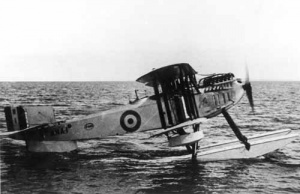Fairey IIID
| Type |
Spotter/Reconnaissance Seaplane |
|---|---|
| Manufacturer |
Fairey Aviation Co Ltd |
| Number in use |
6 |
| First Delivered |
1921 |
| Final Flight |
1929 |
| Length |
37 feet |
| Height |
11 feet 4 inches |
| Weights | 3990 |
| Dimensions | Wing span: 46 feet 1¼ inches |
| Speed | 106 mph |
| Range |
550 miles |
| Crew |
3 |
| Engines | One 375 hp Rolls Royce Eagle VIII |
| Performance |
|
| Armament |
One Vickers machine gun, one Lewis machine gun |
| Ships embarked in | HMAS Geranium |
The Royal Australian Navy (RAN) had operated aircraft from its larger ships during World War I and many naval personnel had seen the advantages of naval air power during the war. In 1919-20 the RAN took steps to form its own naval air service but met with opposition from within the Government and the Australian Air Corps, an interim force formed from the remnants of the Australian Flying Corps, that pushed for a single independent air force for Australia. While this debate continued the RAN continued with plans to purchase seaplanes and July 1920 staff at the Australian High Commission in London selected the Fairey IIID seaplane as the most suitable aircraft for Australian conditions.
In early April 1921 the Australian Government announced its intentions to purchase 12 Fairey IIID seaplanes for the Royal Australian Navy from the Fairey Aviation Co Ltd UK for the sum of approximately £45,000. Financial constraints reduced the actual order to only six aircraft, with additional engines, spares and specialist tools with a contract value of £23,000 pounds. As the order had been placed for the RAN the six aircraft were given serial numbers ANA-1 to ANA-6; with ANA standing for Australian Naval Aircraft.
They were manufactured at the Fairey Aviation Works, in Hamble Southampton during the period May-September 1921 and the first aircraft ANA-1 was accepted at Hamble by Mrs Mary Hughes, wife of Australia’s Prime Minister on 12 August 1921. The last aircraft was delivered in early September and all six were then prepared for delivery to Australia. This involved disassembling the aircraft which were then crated and loaded onto the Australian Commonwealth Line steamer SS Boonah and shipping them to Australia. Boonah departed the United Kingdom in late September and arrived in Australia in early November 1921.
By then the formation of an RAN Air Service had been quashed by the formation of the Australian Air Force on 31 March 1921 (with the Royal prefix added on 31 August 1921). The six aircraft were delivered with the marking ‘ANA’ on the fuselage and rudder and accepted by the Royal Australian Air Force (RAAF) who renumbered the aircraft as A10-1 to A10-6. Due to defence spending cutbacks and a shortage of trained personnel in the new RAAF only one aircraft was reassembled and used for training. The remaining five were placed in storage but by mid-1923 all the aircraft had been assembled.
Fairey A10-3 flown by Wing Commander Stanley Goble and Flight Lieutenant Ivor McIntyre completed the first around Australia flight during April-May 1924; covering over 8500 miles in 90 flying hours over an uncharted course and in face of numerous difficulties. The flyers were awarded the 1924 Britannia Trophy, and the contemporary press classed the flight “the finest in the history of aviation.”
In late 1924, A10-2 operated in Queensland waters supporting survey work being conducted by the survey vessel HMAS Geranium. The aircraft was flown, in stages, from Point Cook to Townsville and then embarked in Geranium. The aircraft was of substantial assistance in identifying channels in the Great Barrier Reef for survey and also locating isolated shoals. In 1925 a Fairey IIID were allocated to surveying duties with the RAN in north Queensland waters but this time the aircraft were based ashore at Townsville. The seaplanes operating in support of the RAN were known as 101 Flight.
Co-operation tasks were also carried out with naval units and during 1925-1927 Fairey IIID aircraft would operate from Eden to provide support to RAN warships conducting exercises off the east coast.
The Fairey IIID was popular with their aircrew but they were quite difficult to maintain and when used in tropical and sub-tropical areas their performance was significantly degraded. By the end of 1925 three of the six had crashed or were damaged beyond repair. They were converted to spare parts to keep the other three aircraft operational. Due to a lack of spare parts, funding and qualified maintenance personnel the remaining three aircraft were unserviceable by late 1927 and were disposed of in 1929.




